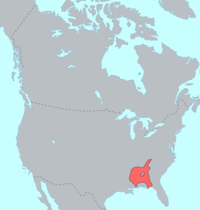Muskogee languages
Muskogee or " Maskoki " is an Native American language family from the southeastern United States . The language code according to ISO 639-2 is mus.
Division of the language family
The Maskoki languages are divided into two main branches, the eastern and the western. These distinctions are currently still being debated. They are among the agglutinating languages . The traditional classification is from Mary Haas and her students. A younger and more controversial classification was suggested by Pamela Munro .
The Houma vocabulary could be another undocumented Western Maskoki language, or it could be a version of the Mobilian pidgin. Mobilian-Pidgin is a pidgin language based on Western Maskoki ( List of Pidgin Languages ).
Some linguists have grouped the Muskogee languages together with some isolated individual languages into a hypothetical family of the Gulf languages .
Haas
I. West Maskoki
II. East Maskoki
- A. Central Maskoki
- i. Apalachee Alabama Koasati Group
- ii. Hitchiti-Mikasuki
- B. Maskoki Group
- 7. Maskoki (Creek)
Munro
I. North Maskoki
II. South Maskoki
- A. Southwest Maskoki Group:
- B. Hitchiti Mikasuki Group:
Relationships
The Muskogean languages may be with the Natchez language from Louisiana related.
Features of the language family
Phonology
The Maskoki languages have a relatively simple phonology compared to other Indian languages. Proto-Maskoki contained the phonemes / pt tS kg K shmnlwy / (in X-Sampa notation). The Western Maskoki languages differentiate between / s / and / S /. Many of the languages distinguish the voiceless / p / from the voiced / b /; voiced labials are rare in Indian languages. The Maskoki languages have pitch accents.
Nouns
Most family languages have lexical accents on nouns as well as grammatical cases that distinguish the subject from the object. The nouns do not necessarily indicate gender and number.
Verbs
Maskoki verbs have a complex ablaut system, whereby the root of the verb changes with the aspect (almost always) or also depends on the tension or modality. In Maskoki linguistics, the various forms are called "degrees".
The verbs indicate the first and second person, as well as active and passive ( Choctaw also indicates the dative object). Third persons (he, she, it) have a zero marker.
The plurality of a subject is indicated either by 1) affixing the verb or 2) an already original plural stem of the verb. The latter is a very distinctive feature of the Maskoki languages.
Example (pluralization through affixation, Choctaw)
ishimpa
ish-impa
2SG.NOM-essen
"du isst"
hashimpa
hash-impa
2PL.NOM-essen
"ihr esst"
Example (originally numerous word stems, Mikasuki)
łiniik
rennen.SG
"rennen (Singular)"
palaak
rennen.PAUCAL
"rennen (mehrere)"
mataak
rennen.PL
"rennen (viele)"
Web links
- North and Mesoamerican languages
- Paper on Roots of Muskogean languages (discusses classifications; PDF file; 1.03 MB) - in the web archive
bibliography
- Campbell, Lyle. (1997). American Indian languages: The historical linguistics of Native America . New York: Oxford University Press. ISBN 0-19-509427-1 .
- Goddard, Ives (Ed.). (1996). Languages . Handbook of North American Indians (WC Sturtevant, General Ed.) (Vol. 17). Washington, DC: Smithsonian Institution. ISBN 0-16-048774-9 .
- Haas, Mary. (1973). The southeast. In TA Sebeok (Ed.), Linguistics in North America (part 2, pp. 1210-1249). The Hauge: Mouton.
- Mithun, Marianne. (1999). The languages of Native North America . Cambridge: Cambridge University Press. ISBN 0-521-23228-7 (hbk); ISBN 0-521-29875-X .
- Sebeok, Thomas A. (Ed.). (1973). Linguistics in North America (parts 1 & 2). Current trends in linguistics (Vol. 10). The Hauge: Mouton. (Reprinted as Sebeok 1976).
- Sturtevant, William C. (Ed.). (1978 - present). Handbook of North American Indians (Vol. 1-20). Washington, DC: Smithsonian Institution. (Vols. 1-3, 16, 18-20 not yet published).
